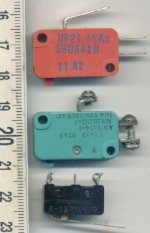Is the stobe on the PL-71 actually reading the platter speed or is it ran by the 60Hz to show a reference. It's possible your line frequency may be varying slightly.
I gave the pots a good clean with some dioxit when I did the recap, so replacement seems in order, perhaps.
I have been relying on the strobe built in to the TT. The fluctuation seems to be at the same point every revolution. So, before I do any more soldering, I think I'll try a dash of lubrication and see if that takes care of the hesitation at the one spot as it spins.
I have been relying on the strobe built in to the TT. The fluctuation seems to be at the same point every revolution. So, before I do any more soldering, I think I'll try a dash of lubrication and see if that takes care of the hesitation at the one spot as it spins.
It has been a while since this post had action but it seems somewhat appropriate for my situation with my PL-71. When I turn it on and push the speed selector, the motor starts to turn just for a second then stops. I'm new to all of this turntable terminology so go easy on a reply. Why would it start then just stop? it moves maybe a 1/4 of an inch before stopping.
Thanks. Are you referring to the micro switches next to the pots? That's the only switches I know of.
Yes.
The 33 and 45 buttons will activate the power switch (turning the TT on) as well as the appropriate speed select switch when depressed, the power off button will open those switches. (turning things off)
There is some mechanical interconnection with those three buttons, but the switches themselves are standard snap action Microswitches, similar to the photo below.
The 33 and 45 buttons will activate the power switch (turning the TT on) as well as the appropriate speed select switch when depressed, the power off button will open those switches. (turning things off)
There is some mechanical interconnection with those three buttons, but the switches themselves are standard snap action Microswitches, similar to the photo below.
Attachments
Hi 6L6, I finally got a chance to check out the micro switches. I did find a loose wire. I soldered it back but get the same response from the motor. I did notice that the 33 rpm button does nothing but the 45 button is the one that tries to start the motor.
I tested the switches and when you press the button they both test with continuity. If this is the case could the switch still be bad or would it be something else or the DC converter board?
I tested the switches and when you press the button they both test with continuity. If this is the case could the switch still be bad or would it be something else or the DC converter board?
Thanks MattHauck. I ran into something strange with my PL71. In the photos of the restoration work done in this thread, the image shows 3 micro switches. My PL71 only has 2. We're there different models of this TT? The 2 that are on mine, are next to each other close to the pots. One under the 33 button and the other under the 45. The 33 switch has 2 white wires going to the power board and the other has wires coming from the pots. I would post a photo but I have already taken the switches out. I don't know if someone who owned it before, made mods or not. Do you think I should re-wire to have three switches? I started this project because it would not turn on to begin with. However, I was told it used to work fine and just quit running.
I my student days I modified a pl71 of a friend as a birthday present. I replaced the tonearm by a wooden one, made of juniper wood. we were surprised by the improved sound, a lot more detail and depth.
That is interesting that a wooden tone arm would change a sound that is electronically generated. How does that work?
The vinyl record is cut with a 90 degree chisel that cuts walls of 45 degrees in the vinyl. each wall has it's own left or right channel modulated.
the wall movement moves the needle of the cartridge and these forces are also transferred into the tonearm , that needs to be stiff and with much selfdamping in order not to influence the sound. A metal arm is indeed stiff but lacks damping. My other tonearm is of old honduras mahonia, a kind of wood light and stiff due to the intertwined fibers grown in the tropical environment. A long time ago peter pritchard built and sold wooden tonearms.
https://www.stereophile.com/content/peter-pritchard
the wall movement moves the needle of the cartridge and these forces are also transferred into the tonearm , that needs to be stiff and with much selfdamping in order not to influence the sound. A metal arm is indeed stiff but lacks damping. My other tonearm is of old honduras mahonia, a kind of wood light and stiff due to the intertwined fibers grown in the tropical environment. A long time ago peter pritchard built and sold wooden tonearms.
https://www.stereophile.com/content/peter-pritchard
Can anyone provide input from my post on 3/3 @ 8:04? I'm still puzzled by the wiring difference plus when I put the 2 new switches on, I no longer get the strobe light which I was getting after putting in a new power board. The board that the plug wires go to, not the one that converts to DC.
- Home
- Source & Line
- Analogue Source
- Restoration and Modification of Pioneer PL-71 turntable

